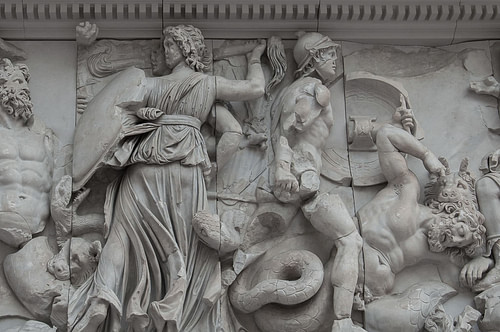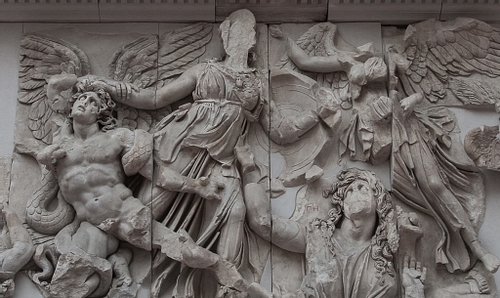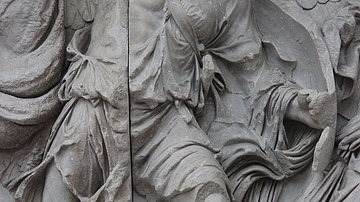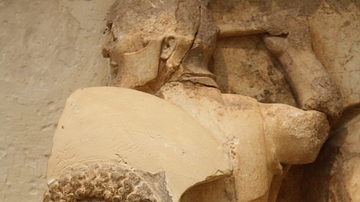
In Greek mythology, the Giants (Gigantes) are an aggressive race of creatures who were born from Gaia (the Earth) after drops of Uranus' blood fell on the Earth after he was castrated. The Giants had great strength and were fearsome to look upon, with long hair and scaly feet.
There were many different Giants, some having more prominent roles in mythology than others. The most famous story involving the Giants is the Gigantomachy (Revolt of the Giants), which came after the Titanomachy.
Giants have since become a common sight in various fantasy and science fiction movies, books, and TV shows, including the Harry Potter series (both books and films), the movie The Princess Bride (1987), and the book The BFG by Roald Dahl (1916-1990), and the movie The BFG (2016) that was based on the book. They have been portrayed as both friendly, gentle beings who make friends with humans and menacing, cruel figures who use their brute strength for harm rather than good.
Birth
The Giants sprung from Gaia after Uranus was emasculated by his son Cronus, and drops of his blood fell upon the Earth.
They did not fall
From his hands in vain, for all the bloody drops
That leaped out were received by Earth; and when
The year's time was accomplished, she gave birth
To the Furies, and the Giants, strong and huge,
Who fought in shining armour, with long spears.
Apollodorus wrote that Gaia gave birth to the Giants because she was upset that the Olympians had conquered the Titans. The Latin author Hyginus (64 BCE to 17 CE) states that the Giants were the offspring of Gaia and Tartarus (the deepest part of the Underworld).
Description & Characteristics
According to the Greek writer Pseudo-Apollodorus in his Bibliotheca, the Giants were unmatched in size with a frightening appearance - they had long hair that flowed down from their head and chin and had serpent scales on their feet and legs. Hesiod (c. 700 BCE) described them as being 'great' and 'strong' with shining armour and long spears. Pindar (c. 518 BCE) stated that the Giant Porphyrion was incredibly violent. The poet Bacchylides (c. 516-451 BCE) called them arrogant.
In later years, the Giants had snakes in place of their legs, and they became more monstrous in nature and larger in stature. Ovid (43 BCE to 17 CE) listed them as having a hundred arms and being snake-footed, while Nonnus described them as 'serpent-haired.' According to most ancient sources, the Giants resided either in Thrace or Pellene. Their brute strength and aggression were usually on display as they often used rocks and boulders as weapons, being able to hurl them long distances.
In Homer's (c. 750 BCE) Odyssey, he writes about the legendary Laestrygonians and how they were more like Giants than humans in appearance.
Down from the cliff they flung great rocks a man could hardly hoist
and a ghastly shattering din rose up from all the ships –
men in their death cries, hulls smashed to splinters-
They speared the crews like fish
and whisked them off to make their grisly meal.(Homer, Odyssey, 10-132-136).
Notable Giants
There were multiple Giants in Greek mythology, some better known than others. Among the most notable of the giants is Porphyrion, who was the king of the Giants and who was killed by Zeus and Hercules after he had attempted to rape Athena; Enceladus, who was buried underneath Mount Etna by Athena; Polybotes, who was crushed by an island that was thrown by Poseidon and Alcyoneus, who was immortal, as long as he fought on his homeland. Most of the Giants fought various gods and were defeated, often with the help of a particular weapon or tool.
The Gigantomachy
Apollodorus (c. 180 to c. 120 BCE) stated that the Gigantomachy took place after the Titanomachy. It was considered one of the crucial battles that cemented the sovereignty of the Olympian gods. The Giants were angry at Zeus, as he had imprisoned their brothers, the Titans, in Tartarus. They plotted their revenge by planning an attack on the heavens. On their mountaintops, the Giants grabbed firebrands and boulders and threw them upward. Hera foresaw that a god could never kill the Giants, but only a mortal who was lion-skinned could defeat them, referring to the Greek hero Hercules. However, even Hercules would need the assistance of a herb that made a mortal invulnerable. Gaia knew of the existence of this herb and tried to search for it herself. However, this herb grew in a dark secret place under the Earth, and so Zeus forbade Selene, Helios, and Eros to shine and found the herb first with Athena's help. The Olympians were now in a position to fight the Giants.
Hercules did not waste time and shot an arrow at Alcyoneus, the leader of the Giants, who was instantly revived because he was fighting on his own land. On the advice of Athena, Hercules took Alcyoneus over the border, where he was able to kill him. Porphyrion jumped up into Heaven, and only Athena stood her ground against him. He rushed past her and went to Hera, whom he tried to strangle. An arrow from Eros hit him, and his violence instantly turned to lust. Attempting to rape Hera, he was stopped by Zeus, who struck Porphyrion with his thunderbolt. Porphyrion did not stay down for long but was ultimately killed by Hercules.
Ephialtes was fighting against Ares and had driven him to his knees. Apollo came to Ares' rescue, shot the Giant in his left eye, and called out to Hercules for help. Hercules shot Ephialtes in the right eye, ending his life. A fierce battle raged on between the gods and the Giants. Dionysos used his staff (thyrsus) to bring down Eurytus; Hecate burned Clytius with her torches; Athena crushed Pallas with a boulder, and Hephaestus scalded Mimas with hot metal. Every time a god injured a Giant, Hercules would come running to deliver the killing blow. Only two Olympian goddesses were notably absent from the conflict, the peaceful Demeter and Hestia, who watched the battle from afar in dismay but refused to take part in it.
The Giants could see they were fighting a losing battle and retreated to Earth with the Olympians pursuing them. Athena threw a large item at Enceladus, which crushed him and buried him, becoming Mount Etna in Sicily. Poseidon used his trident to break off a piece of Kos in the Aegean Sea and threw it at Polybotes, who also transformed into a piece of land – the Isle of Nisyros. The surviving Giants made a last stand at Bathos in Arcadia. Hermes, wearing Hades' helmet, struck down Hippolytus, while Artemis shot an arrow at Gration. The Fates used their pestles to smash the heads of Thoas and Agrius. Ares and Zeus used their spear and thunderbolt to take down the remaining Giants, with Hercules killing each Giant as they fell. In some sources, the companion of Dionysos, Silenus, boasted about fighting on the side of the gods and killing the Giant Enceladus. His braying sent the Giants running in fear.

Aftermath
After the Giants were defeated, their mother, Gaia, lay with Tartarus and gave birth to Typhon, the largest monster to ever roam the Earth. In his Metamorphoses, Ovid writes that Gaia transformed the Giants into a new race.
When, crushed by the mass they had raised, those
fearsome bodies lay prostrate,
Mother Earth, as the story continues, now steeped and
drenched
in the blood of her offspring, gave fresh life to the
seething liquid.
Unwilling that all the fruits of her womb should be lost and forgotten,
she turned their blood into human form; but the new race
also
looked on the gods with contempt. Their passionate lust for
ferocious
violence and slaughter prevailed. You'd have known they
were born of blood.(Ovid, Metamorphoses, 1.156-163)
Alternative Versions
According to the Greek poet Pindar, the Giant Alcyoneus was the catalyst for the conflict between the Olympian gods and the Giants. In various versions, he either stole some of Helios' cattle, which angered the god, or confronted Hercules either as he was returning from his Trojan expedition with Telamon or at the Isthmus of Corinth. A scene from a vase painting shows Hercules creeping up on Alcyoneus as he is sleeping and attacking him.
In the Ancient Greek World
According to Pausanias (c. 115 to c. 180 CE) in his Description of Greece, in the region of Trapezus in Arcadia, there was a place called the Depth, where the Mystery of the Great Goddesses was celebrated every two years. Not far from the Depth was a spring called the Olympias, which is where the legendary Gigantomachy was said to have taken place. Sacrifices were made here to the storms, lightning, and thunder.
On the south wall of the Acropolis in Athens was a wall relief that depicted the great battle between the gods and the Giants. A short distance away from the Temple of Demeter in Athens stood a statue of Poseidon on horseback, throwing a spear towards the Giant Polybotes.











